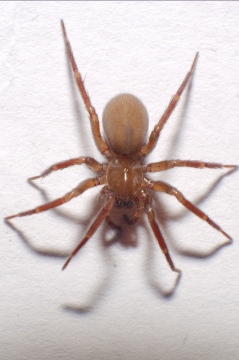Summary for Cicurina cicur (Araneae)
previous species | next species
National Distribution
Terms of Use. Double-click on map to go to region

Explore Regional Distribution
View notes or log on and add a note on this species
About this species
Recorded altitude range1m to 401m
Species text
DistributionThe species is widespread in parts of eastern and central England with single records in Scotland and Wales. It is widespread in north-western and central Europe but has not been recorded from Ireland and is on the Red List in Sweden (Gärdenfors 2000).
Habitat and ecology
The species is often found in dark, damp situations such as woodland litter and in caves, drains and cellars where the spider spins a sheet web with a small retreat. Smith (1989) notes all recent records in Yorkshire refer to those parts of the county where chalk or magnesian limestone is the basic geological formation. Females have been found under stones in disused quarries, railway cuttings, etc. and numerous males have been taken in pitfall traps set in chalk grassland on steep, well-drained hillsides. Crocker & Daws (1996) also give some records from more open habitats and note a possible link with calcareous sites in Leicestershire. A similar association with calcareous sites occurs in Dorset. The spider has also been found in fairly open conditions on exposed chalk on the South Downs. However, in Bedfordshire pitfalls in well-drained acid grassland have turned up this species, while in Cambridgeshire good numbers have been trapped in winter on heavy clay in arable fields. Both sexes have been found from the autumn through the winter to spring, females occasionally persisting into the summer.
Status
A very local species, recorded from 66 hectads since 1992, showing a small apparent decline.
Threats
Given the fairly wide range of different habitats it has been found in, the nature of any threats is difficult to determine at present.
Management and conservation
No recommendations at present.
Text based on Dawson, I.K., Harvey, P.R., Merrett, P. & Russell-Smith, A.R. (in prep.). References
Adult Season
Habitats
background methodology
Recorded management for locations with Cicurina cicur
Recorded substrate and hydrology for locations with Cicurina cicur
Images
please log on and upload a new image for this speciesSee also A-Z Species Index - A-Z Picture Index - previous species | next species



